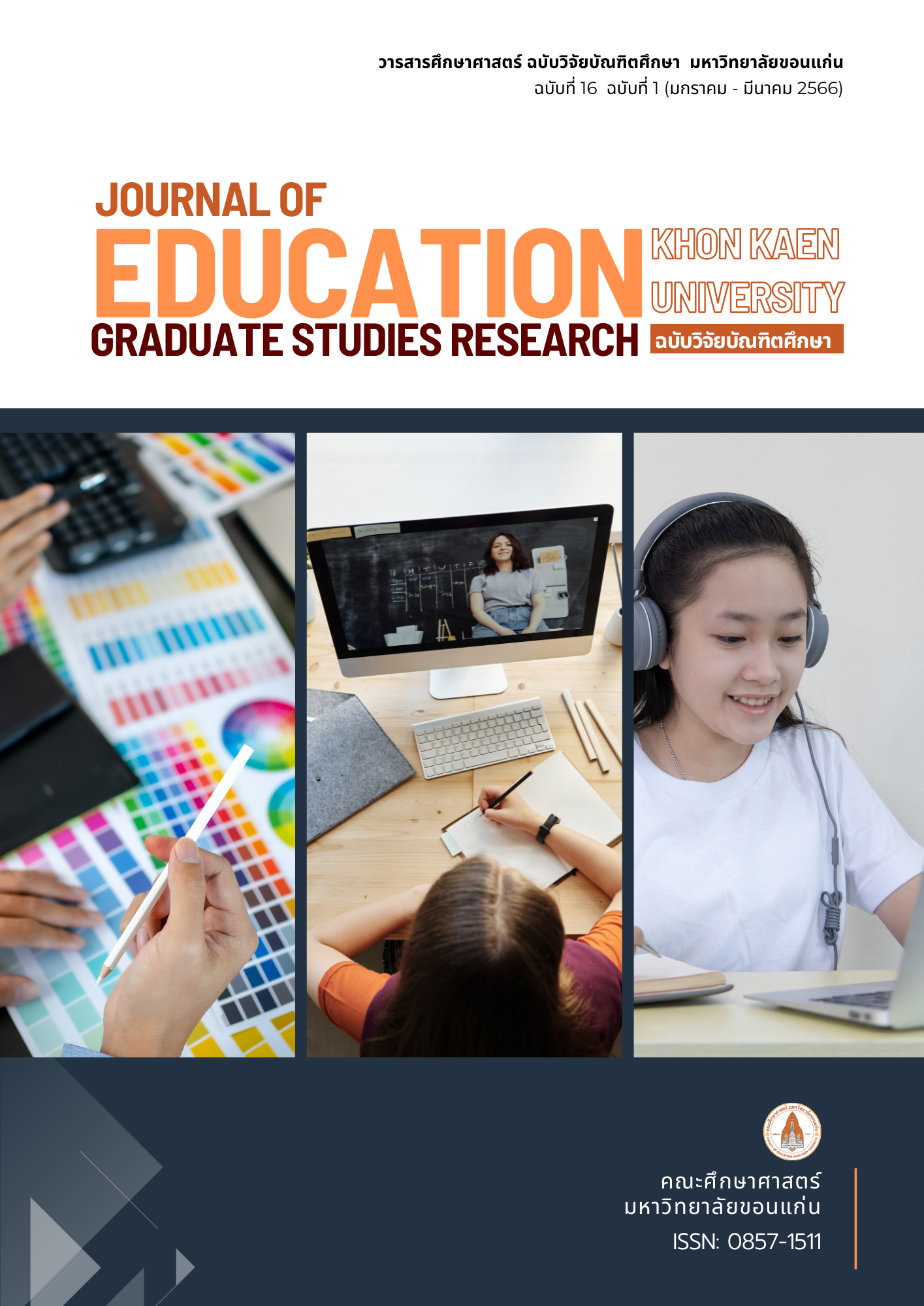THE DEVELOPMENT OF CONSTRUCTIVIST WEB-BASED LEARNING ENVIRONMENTS TO ENHANCE LEARNERS’ INFORMATION PROCESSING AND REDUCTION OF COGNITIVE LOAD ON THE TOPIC OF ILLNESS VOCABULARY FOR FIFTH – GRADE STUDENTS INTEGRETION BETWEEN PEDAGOGY AND NEUROSCIENCE
Main Article Content
Abstract
The purpose of this research was to design and develop Constructivist learning environment model to enhance Learners Information Processing, to examine the students’ Learners Information Processing, to study the student’ learning achievement and the opinion of the students toward the Constructivist learning environment model Learners Information Processing and to study brain waves of the students while they were performing the Learners Information Processing tasks. Model Research (Richey & Klein, 2007) was employed in this study. There were three phases: 1) Model Development 2) Model Validation and 3) Model Use. The result revealed that 1) The design and development of the Constructivist learning environment model, based on Designing framework consisted of 7 components: (1) Problem Bases, 2) Vocabulary center 3) Cognitive tools center 4) Collaboration center 5) Scaffolding center 6) Cognitive apprenticeship center and 7) Enhance information processing and reduction of cognitive load center. 2) The learners’ information processing learning with cognitive innovation to enhance knowledge construction and memory process base on Klausmeier (1985) consist of 3 processes: 1) sensory register, 2) short-term memory, and 3) long-term memory. 3) The student's COGNITIVE LOAD while performing the information processing task of the learners who studied with the Learning Environment Model found that the students had the ability to reduce the COGNITIVE LOAD. 4) The learning achievement scores of students found that the mean of the achievement scores ( )) accounted for 84.00% of the full score, indicating that they had an achievement score of 70 percent of the full score, and students 86.67% of the total number of students. Passed 80 percent of the total number of students. 5) Learner’s opinions toward Learning Environment Model found that: the design and development of learning environment model were appropriated in all aspects such as learning contents, wed-based learning environments, and supporting and encouraging them to enhancing knowledge construction, information processing and Reductive of Cognitive load. 6) The brain wave of students in the specified position of the brain areas specific to Learners Information Processing while they were performing the Learners Information Processing task in the Constructivist learning environment model showed that Alpha waves were found associated with intellectual as Learners Information Processing activity in the scalp area in position AF3, AF4, F3, F4, F7, and F8.
Article Details

This work is licensed under a Creative Commons Attribution-NonCommercial-NoDerivatives 4.0 International License.
References
จารุณี ซามาตย์. (2552). การพัฒนาโมเดลสิ่งแวดล้อมการเรียนรู้ตามแนวคอนสตรัคติวิสต์บนเครือข่ายตามแนวคอนสตรัคตวิสต์ที่ส่งเสริมการคิดสร้างสรรค์ของนักศึกษาระดับอุดมศึกษา. วิทยานิพนธ์ปริญญาปรัชญาดุษฎีบัณฑิต สาขาวิชาเทคโนโลยีการศึกษา บัณฑิตวิทยาลัย มหาวิทยาลัยขอนแก่น.
จุรีรัตน์ เพียสาร. (2549). ผลของมัลติมีเดียที่พัฒนาตามแนวคอนสตรัคติวิสต์ รายวิชาภาษาอังกฤษ เรื่องส่วนต่างๆ ของร่างกาย สำหรับนักเรียนชั้นประถมศึกษาปีที่ 5. [ม.ป.ท.]: มหาวิทยาลัยขอนแก่น.
นุชนาจ พลอยพันธ์, สุมาลี ชัยเจริญ และชลิสา โพธิ์นิ่มแดง. (2549). ผลของมัลติมีเดียที่พัฒนาตามแนวทฤษฎีพุทธิปัญญา
ที่ใช้ keyword method สาระการเรียนรู้ภาษาต่างประเทศ เรื่องสัตว์ ชั้นประถมศึกษาปีที่ 5. วารสารเทคโนโลยีทางปัญญา, 1(1), 76-85.
ปรัศณียา กองอาษา. (2546). ผลของการใช้บทเรียนคอมพิวเตอร์ช่วยสอนแบบมัลติมีเดียที่พัฒนาตามแนวทางพุทธิปัญญาบนพื้นฐานการขยายความคิด. วิทยานิพนธ์ปริญญาศึกษาศาสตรมหาบัณฑิต สาขาวิชาเทคโนโลยีการศึกษา บัณฑิตวิทยาลัย มหาวิทยาลัยขอนแก่น.
พวงทอง เพชรโพน. (2555). การออกแบบและพัฒนาโมเดลสิ่งแวดล้อมการเรียนรู้บนเครือข่ายที่ส่งเสริมทักษะทางปัญญา และการคิดอย่างมีวิจารณญาณสำหรับนักศึกษาระดับปริญญาตรี. วิทยานิพนธ์ปริญญาปรัชญาดุษฎีบัณฑิต สาขาวิชาเทคโนโลยีการศึกษา บัณฑิตวิทยาลัย มหาวิทยาลัยขอนแก่น.
สำนักงานคณะกรรมการศึกษาแห่งชาติ. (2545). พระราชบัญญัติการศึกษาแห่งชาติ พ.ศ. 2542 และที่แก้ไขเพิ่มเติม (ฉบับที่ 2) พ.ศ. 2545. กรุงเทพฯ: พริกหวานกราฟฟิค.
สุชาติ วัฒนชัย และคณะ. (2551). รายงานการวิจัย เรื่อง การออกแบบและพัฒนานวัตกรรมการเรียนรู้ที่ส่งเสริมศักยภาพ การเรียนรู้ทางสมองของผู้เรียนโดยใช้ Brain-Based Learning. ขอนแก่น: ศูนย์วิจัยนวัตกรรมและเทคโนโลยีทางปัญญา มหาวิทยาลัยขอนแก่น
สุมาลี ชัยเจริญ. (2559). การออกแบบการสอน: หลักการ ทฤษฏีสู่การปฏิบัติ. พิมพ์ครั้งที่ 2. ขอนแก่น: คลังนานา.
Klausmeier, H.J. (1985). Educational Phycology. 5th ed. New York: Harper & Row.
Richey, R.C. & Klein, J. (2007). Design and developmental research. New Jersey: Lawrence.
Mayer, R.E. (2005). Cognitive theory of multimedia learning. In R.E. Mayer (Ed.). The Cambridge Handbook of Multimedia Learning. (pp. 224-238). New York: Cambridge University Press.

